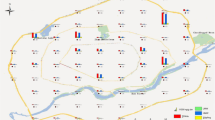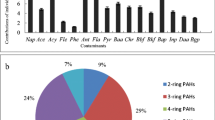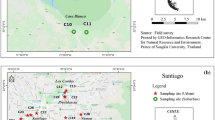Abstract
Polycyclic aromatic hydrocarbons (PAHs) in urban soils may pose a serious threat to human health via oral ingestion, dermal absorption, and particulate inhalation, especially in public parks and playgrounds, with children and senior citizens showing the highest susceptibility. Several studies have been undertaken identifying PAHs in urban soils, but no studies to date have assessed PAHs in urban parks, in particular in exposed-lawn soils. In recent decades, unprecedented rates of urbanization and industrialization in China have resulted in significant levels of urban environmental pollution. However, concentrations, sources, and the health risk associated with PAH exposure via urban park lawn soils in China remain unknown. The concentrations, sources, and health risk of exposure to 16 PAHs in surface-exposed lawn soils were studied in 28 urban parks in Guangzhou. Concentrations of Σ16PAHs ranged from 76.44 to 890.85 ng/g with a mean of 286.11 ng/g. PAH composition was mostly characterized by 2- and 4-ring PAHs in most sampling parks; Nap, Flua, Pyr, Phe, and Chr were the dominant constituents. Principle component analysis coupled with multivariate linear regression indicated that vehicular and coal combustion emissions contributed to 50.53 and 49.46% of PAHs in Guangzhou’s urban park soils, respectively. Total cancer risk (TCR) analysis found that 22 parks (accounting for 78.57% total parks) designed for children’s use and general-use park areas presented a potentially high risk (>1 × 10−4) for all users.




Similar content being viewed by others
References
Benner BA Jr, Gordon GE, Wise SA (1989) Mobile sources of atmospheric polycyclic aromatic hydrocarbons: a roadway tunnel study. Environ Sci Technol 23:1269–1278
Bi XH, Sheng GY, Peng PA, Chen YJ, Zhang ZQ, Fu JM (2003) Distribution of particulate-and vapor-phase n-alkanes and polycyclic aromatic hydrocarbons in urban atmosphere of Guangzhou, China. Atmos Environ 37:289–298
Bi X et al (2016) Polycyclic aromatic hydrocarbons in soils from the Central-Himalaya region: distribution, sources, and risks to humans and wildlife. Sci Total Environ 556:12–22
Blokker EM, van de Ven BM, de Jongh CM, Slaats PN (2013) Health implications of PAH release from coated cast iron drinking water distribution systems in the Netherlands. Environ Health Perspect 121:600
Bucheli TD, Blum F, Desaules A, Gustafsson Ö (2004) Polycyclic aromatic hydrocarbons, black carbon, and molecular markers in soils of Switzerland. Chemosphere 56:1061–1076
Cachada A, Pato P, Rocha-Santos T, da Silva EF, Duarte AC (2012) Levels, sources and potential human health risks of organic pollutants in urban soils. Sci Total Environ 430:184–192
Cachada A, Ferreira da Silva E, Duarte AC, Pereira R (2016) Risk assessment of urban soils contamination: the particular case of polycyclic aromatic hydrocarbons. Sci Total Environ 551–552:271–284
Chen M, Huang P, Chen L (2013) Polycyclic aromatic hydrocarbons in soils from Urumqi, China: distribution, source contributions, and potential health risks. Environ Monit Assess 185:5639–5651
Chung MK, Hu R, Cheung KC, Wong MH (2007) Pollutants in Hong Kong soils: polycyclic aromatic hydrocarbons. Chemosphere 67:464–473
Duval M, Friedlander S (1981) Source resolution of polycyclic aromatic hydrocarbons in the Los Angeles atmosphere application of a CMB with first-order decay. United States Environmental Protection Agency, Washington, DC
Gu YG, Wang ZH, Lu SH, Jiang SJ, Mu DH, Shu YH (2012) Multivariate statistical and GIS-based approach to identify source of anthropogenic impacts on metallic elements in sediments from the mid Guangdong coasts, China. Environ Pollut 163:248–255
Gu YG, Lin Q, Lu TT, Ke CL, Sun RX, Du FY (2013) Levels, composition profiles and sources of polycyclic aromatic hydrocarbons in surface sediments from Nan’ao Island, a representative mariculture base in South China. Mar Pollut Bull 75:310–316
Gu YG, Gao YP, Qin L (2016a) Contamination, bioaccessibility and human health risk of heavy metals in exposed-lawn soils from 28 urban parks in southern China’s largest city, Guangzhou. Appl Geochem 67:52–58
Gu YG, Ke CL, Liu Q, Lin Q (2016b) Polycyclic aromatic hydrocarbons (PAHs) in sediments of Zhelin Bay, the largest mariculture base on the eastern Guangdong coast, South China: characterization and risk implications. Mar Pollut Bull. doi:10.1016/j.marpolbul.2016.06.025
Gu YG, Lin Q, Gao YP (2016c) Metals in exposed-lawn soils from 18 urban parks and its human health implications in southern China’s largest city, Guangzhou. J Cleaner Prod 115:122–129
Harrison RM, Smith D, Luhana L (1996) Source apportionment of atmospheric polycyclic aromatic hydrocarbons collected from an urban location in Birmingham, UK. Environ Sci Technol 30:825–832
Haugland T, Ottesen RT, Volden T (2008) Lead and polycyclic aromatic hydrocarbons (PAHs) in surface soil from day care centres in the city of Bergen, Norway. Environ Pollut 153:266–272
Imperato M, Adamo P, Naimo D, Arienzo M, Stanzione D, Violante P (2003) Spatial distribution of heavy metals in urban soils of Naples city (Italy). Environ Pollut 124:247–256
Jiang YF, Yves UJ, Sun H, Hu XF, Zhan HY, Wu YQ (2016) Distribution, compositional pattern and sources of polycyclic aromatic hydrocarbons in urban soils of an industrial city, Lanzhou, China. Ecotoxicol Environ Saf 126:154–162
Jiao WT et al (2009) Identification of sources of elevated concentrations of polycyclic aromatic hydrocarbons in an industrial area in Tianjin, China. Environ Monit Assess 158:581–592
Kwon HO, Choi S-D (2014) Polycyclic aromatic hydrocarbons (PAHs) in soils from a multi-industrial city, South Korea. Sci Total Environ 470–471:1494–1501
Lemieux CL, Long AS, Lambert IB, Lundstedt S, Tysklind M, White PA (2015) Cancer risk assessment of polycyclic aromatic hydrocarbon contaminated soils determined using bioassay-derived levels of benzo[a]pyrene equivalents. Environ Sci Technol 49:1797–1805
Li J, Zhang G, Li XD, Qi SH, Liu GQ, Peng XZ (2006) Source seasonality of polycyclic aromatic hydrocarbons (PAHs) in a subtropical city, Guangzhou, South China. Sci Total Environ 355:145–155
Liu SD, Xia XH, Yang LY, Shen MH, Liu RM (2010) Polycyclic aromatic hydrocarbons in urban soils of different land uses in Beijing, China: distribution, sources and their correlation with the city’s urbanization history. J Hazard Mater 177:1085–1092
Luo XS, Ding J, Xu B, Wang YJ, Li HB, Yu S (2012) Incorporating bioaccessibility into human health risk assessments of heavy metals in urban park soils. Sci Total Environ 424:88–96
Marquez-Bravo LG et al (2016) Concentrations of polycyclic aromatic hydrocarbons in New York City community garden soils: potential sources and influential factors. Environ Toxicol Chem 35:357–367
MEP (Ministry of Environmental Protection of China) (2014) Technical guidelines for risk assessment of contaminated sites vol HJ 25.3–2014 (in Chinese)
Nielsen T (1996) Traffic contribution of polycyclic aromatic hydrocarbons in the center of a large city. Atmos Environ 30:3481–3490
Oen AMP, Cornelissen G, Breedveld GD (2006) Relation between PAH and black carbon contents in size fractions of Norwegian harbor sediments. Environ Pollut 141:370–380
Pataki DE et al (2011) Coupling biogeochemical cycles in urban environments: ecosystem services, green solutions, and misconceptions. Front Ecol Environ 9:27–36
Peng C, Chen WP, Liao XL, Wang M, Ouyang ZY, Jiao WT, Bai Y (2011) Polycyclic aromatic hydrocarbons in urban soils of Beijing: status, sources, distribution and potential risk. Environ Pollut 159:802–808
Ramírez N, Cuadras A, Rovira E, Marcé RM, Borrull F (2011) Risk assessment related to atmospheric polycyclic aromatic hydrocarbons in gas and particle phases near industrial sites. Environ Health Perspect 119:1110
Ravindra K, Sokhi R, Van Grieken R (2008) Atmospheric polycyclic aromatic hydrocarbons: source attribution, emission factors and regulation. Atmos Environ 42:2895–2921
Reid MK, Spencer KL (2009) Use of principal components analysis (PCA) on estuarine sediment datasets: the effect of data pre-treatment. Environ Pollut 157:2275–2281
Roweis ST, Saul LK (2000) Nonlinear dimensionality reduction by locallylinear embedding. Science 290:2323–2326
Samanta SK, Singh OV, Jain RK (2002) Polycyclic aromatic hydrocarbons: environmental pollution and bioremediation. Trends Biotechnol 20:243–248
Shen HZ et al (2013) Global atmospheric emissions of polycyclic aromatic hydrocarbons from 1960 to 2008 and future predictions. Environ Sci Technol 47:6415–6424
Tang L, Tang XY, Zhu YG, Zheng MH, Miao QL (2005) Contamination of polycyclic aromatic hydrocarbons (PAHs) in urban soils in Beijing, China. Environ Int 31:822–828
US EPA (1991) Risk assessment guidance for superfund, volume 1, human health evaluation manual (Part B, development of risk-based preliminary remediation goals). EPA/540/R-92/003, pp. 9285.9287-9201B
US EPA (2011) Exposure factors handbook
Vane CH, Kim AW, Beriro DJ, Cave MR, Knights K, Moss-Hayes V, Nathanail PC (2014) Polycyclic aromatic hydrocarbons (PAH) and polychlorinated biphenyls (PCB) in urban soils of Greater London, UK. Appl Geochem 51:303–314
Wang W, Mj Huang, Kang Y, Hs Wang, Leung AOW, Cheung KC, Wong MH (2011) Polycyclic aromatic hydrocarbons (PAHs) in urban surface dust of Guangzhou, China: status, sources and human health risk assessment. Sci Total Environ 409:4519–4527
Wang XT, Miao Y, Zhang Y, Li YC, Wu MH, Yu G (2013) Polycyclic aromatic hydrocarbons (PAHs) in urban soils of the megacity Shanghai: occurrence, source apportionment and potential human health risk. Sci Total Environ 447:80–89
Yang CY et al (2014) Acute effect of ambient air pollution on heart failure in Guangzhou, China. Int J Cardiol 177:436–441
Yu GG, Zhang ZH, Yang GL, Zheng WR, Xu LH, Cai Z (2014) Polycyclic aromatic hydrocarbons in urban soils of Hangzhou: status, distribution, sources, and potential risk. Environ Monit Assess 186:2775–2784
Zhang CS (2006) Using multivariate analyses and GIS to identify pollutants and their spatial patterns in urban soils in Galway, Ireland. Environ Pollut 142:501–511
Zhang Y, Guo CS, Xu J, Tian YZ, Shi GL, Feng YC (2012) Potential source contributions and risk assessment of PAHs in sediments from Taihu Lake, China: comparison of three receptor models. Water Res 46:3065–3073
Acknowledgments
This study was found by Natural Science Foundation of Guangdong Province, China (2014A030310220). The authors thank Yan-Peng Gao, Wen-Dong Gu, Cui-Ying Li, Xiao-Ping Gu, Guang-Wei Wang, and Rui-Qi Wang for providing assistance with the fieldwork.
Author information
Authors and Affiliations
Corresponding author
Electronic supplementary material
Below is the link to the electronic supplementary material.
Rights and permissions
About this article
Cite this article
Ke, CL., Gu, YG. & Liu, Q. Polycyclic Aromatic Hydrocarbons (PAHs) in Exposed-Lawn Soils from 28 Urban Parks in the Megacity Guangzhou: Occurrence, Sources, and Human Health Implications. Arch Environ Contam Toxicol 72, 496–504 (2017). https://doi.org/10.1007/s00244-017-0397-6
Received:
Accepted:
Published:
Issue Date:
DOI: https://doi.org/10.1007/s00244-017-0397-6




